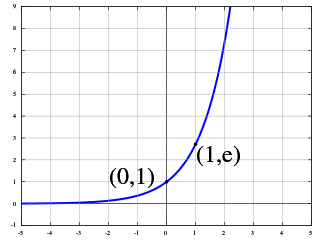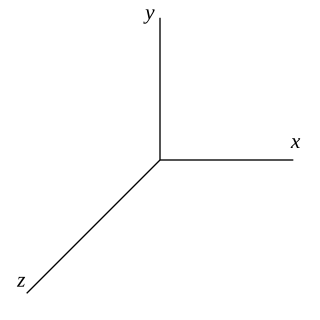
In mathematics, an associative algebraA is an algebraic structure with compatible operations of addition, multiplication, and a scalar multiplication by elements in some field K. The addition and multiplication operations together give A the structure of a ring; the addition and scalar multiplication operations together give A the structure of a vector space over K. In this article we will also use the term K-algebra to mean an associative algebra over the field K. A standard first example of a K-algebra is a ring of square matrices over a field K, with the usual matrix multiplication.

The exponential function is a mathematical function denoted by or . Unless otherwise specified, the term generally refers to the positive-valued function of a real variable, although it can be extended to the complex numbers or generalized to other mathematical objects like matrices or Lie algebras. The exponential function originated from the notion of exponentiation, but modern definitions allow it to be rigorously extended to all real arguments, including irrational numbers. Its ubiquitous occurrence in pure and applied mathematics led mathematician Walter Rudin to opine that the exponential function is "the most important function in mathematics".

In mathematics, the logarithm is the inverse function to exponentiation. That means the logarithm of a number x to the base b is the exponent to which b must be raised, to produce x. For example, since 1000 = 103, the logarithm base 10 of 1000 is 3, or log10 (1000) = 3. The logarithm of x to base b is denoted as logb (x), or without parentheses, logb x, or even without the explicit base, log x, when no confusion is possible, or when the base does not matter such as in big O notation.

Multiplication is one of the four elementary mathematical operations of arithmetic, with the other ones being addition, subtraction, and division. The result of a multiplication operation is called a product.

The natural logarithm of a number is its logarithm to the base of the mathematical constant e, which is an irrational and transcendental number approximately equal to 2.718281828459. The natural logarithm of x is generally written as ln x, logex, or sometimes, if the base e is implicit, simply log x. Parentheses are sometimes added for clarity, giving ln(x), loge(x), or log(x). This is done particularly when the argument to the logarithm is not a single symbol, so as to prevent ambiguity.

In mathematics, rings are algebraic structures that generalize fields: multiplication need not be commutative and multiplicative inverses need not exist. In other words, a ring is a set equipped with two binary operations satisfying properties analogous to those of addition and multiplication of integers. Ring elements may be numbers such as integers or complex numbers, but they may also be non-numerical objects such as polynomials, square matrices, functions, and power series.

In mathematics, exponentiation is an operation involving two numbers, the base and the exponent or power. Exponentiation is written as bn, where b is the base and n is the power; this is pronounced as "b (raised) to the n". When n is a positive integer, exponentiation corresponds to repeated multiplication of the base: that is, bn is the product of multiplying n bases:

A logarithmic scale is a way of displaying numerical data over a very wide range of values in a compact way. As opposed to a linear number line in which every unit of distance corresponds to adding by the same amount, on a logarithmic scale, every unit of length corresponds to multiplying the previous value by the same amount. Hence, such a scale is nonlinear: the numbers 1, 2, 3, 4, 5, and so on, are not equally spaced. Rather, the numbers 10, 100, 1000, 10000, and 100000 would be equally spaced. Likewise, the numbers 2, 4, 8, 16, 32, and so on, would be equally spaced. Often exponential growth curves are displayed on a log scale, otherwise they would increase too quickly to fit within a small graph.
In algebra, a valuation is a function on a field that provides a measure of the size or multiplicity of elements of the field. It generalizes to commutative algebra the notion of size inherent in consideration of the degree of a pole or multiplicity of a zero in complex analysis, the degree of divisibility of a number by a prime number in number theory, and the geometrical concept of contact between two algebraic or analytic varieties in algebraic geometry. A field with a valuation on it is called a valued field.

In abstract algebra, a semiring is an algebraic structure similar to a ring, but without the requirement that each element must have an additive inverse.

In mathematics, tetration is an operation based on iterated, or repeated, exponentiation. There is no standard notation for tetration, though and the left-exponent xb are common.

In mathematics, tropical geometry is the study of polynomials and their geometric properties when addition is replaced with minimization and multiplication is replaced with ordinary addition:
In probability theory and computer science, a log probability is simply a logarithm of a probability. The use of log probabilities means representing probabilities on a logarithmic scale, instead of the standard unit interval.
In idempotent analysis, the tropical semiring is a semiring of extended real numbers with the operations of minimum and addition replacing the usual ("classical") operations of addition and multiplication, respectively.
A logarithmic number system (LNS) is an arithmetic system used for representing real numbers in computer and digital hardware, especially for digital signal processing.

In mathematics, a semifield is an algebraic structure with two binary operations, addition and multiplication, which is similar to a field, but with some axioms relaxed.
In mathematics, the set of positive real numbers, is the subset of those real numbers that are greater than zero. The non-negative real numbers, also include zero. Although the symbols and are ambiguously used for either of these, the notation or for and or for has also been widely employed, is aligned with the practice in algebra of denoting the exclusion of the zero element with a star, and should be understandable to most practicing mathematicians.
In tropical analysis, tropical cryptography refers to the study of a class of cryptographic protocols built upon tropical algebras. In many cases, tropical cryptographic schemes have arisen from adapting classical (non-tropical) schemes to instead rely on tropical algebras. The case for the use of tropical algebras in cryptography rests on at least two key features of tropical mathematics: in the tropical world, there is no classical multiplication, and the problem of solving systems of tropical polynomial equations has been shown to be NP-hard.
In mathematics, the field of logarithmic-exponential transseries is a non-Archimedean ordered differential field which extends comparability of asymptotic growth rates of elementary nontrigonometric functions to a much broader class of objects. Each log-exp transseries represents a formal asymptotic behavior, and it can be manipulated formally, and when it converges, corresponds to actual behavior. Transseries can also be convenient for representing functions. Through their inclusion of exponentiation and logarithms, transseries are a strong generalization of the power series at infinity and other similar asymptotic expansions.

In tropical geometry, a tropical projective space is the tropical analog of the classic projective space.


























